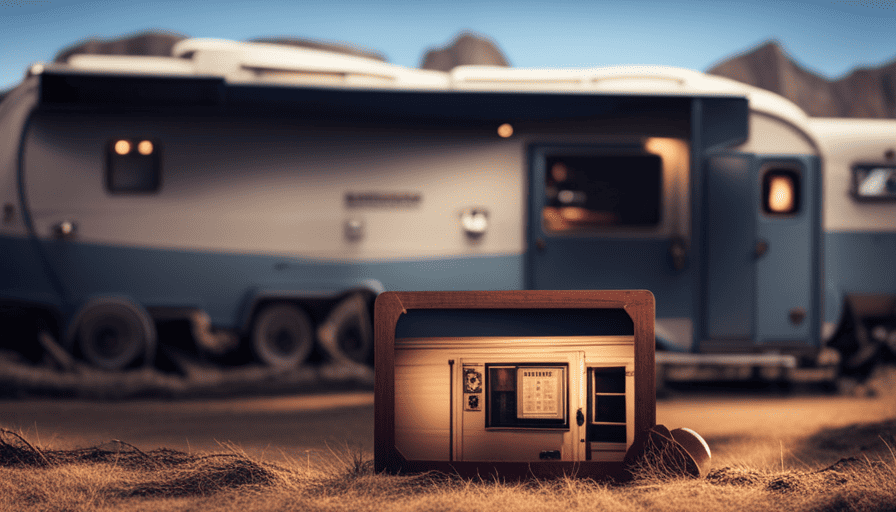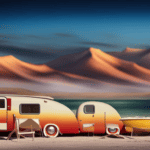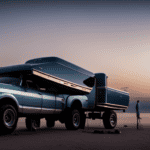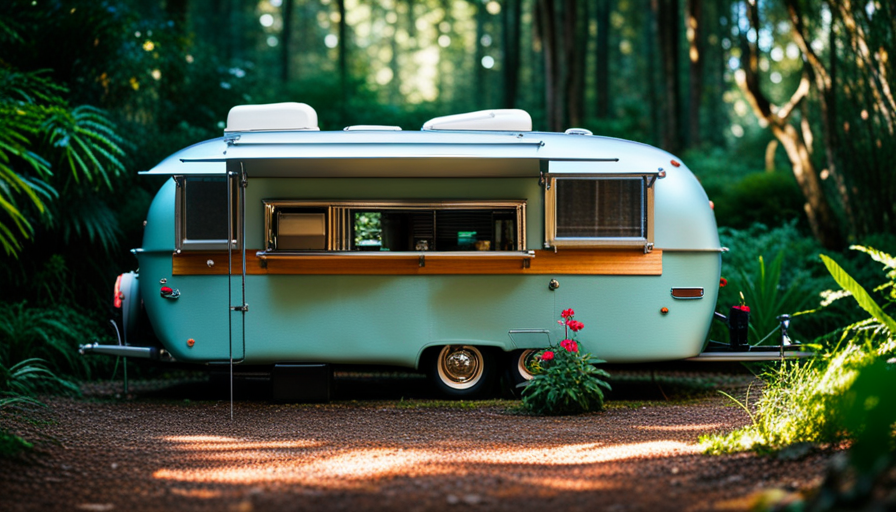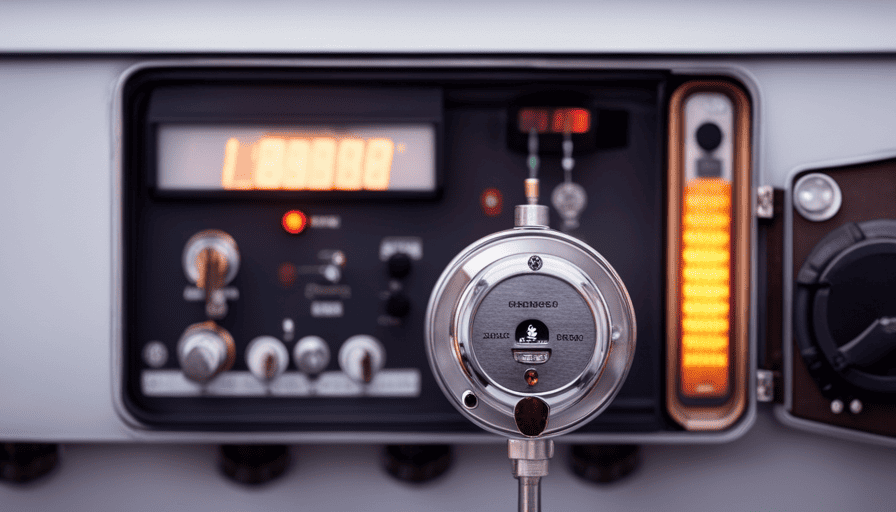Have you ever fantasized about setting off on an open road adventure, discovering new destinations, and enjoying the liberty to go wherever you wish? If you share my sentiment, then you’re aware that owning a camper shell is essential for making that dream come true.
But before you can embark on your epic road trip, you’re probably wondering, ‘How much does a camper shell cost?’ Well, my fellow adventurers, I’m here to shed some light on this topic and help you make an informed decision.
When it comes to camper shells, there are a variety of options available, each with its own price tag. From basic shells to high-end models with all the bells and whistles, the cost can range anywhere from a few hundred dollars to several thousand. Factors such as size, material, features, and brand all play a role in determining the price.
In this article, we’ll explore the different types of camper shells, discuss the considerations you should keep in mind when choosing one, and delve into the average price range you can expect. We’ll also take a look at the factors that can affect the cost of a camper shell, as well as where you can buy them and some tips for finding the best deals.
Additionally, we’ll weigh the pros and cons of owning a camper shell and discuss the DIY versus professional installation dilemma. So, if you’re ready to learn more about the cost of camper shells and embark on your own adventure, let’s dive in!
Key Takeaways
- Camper shells can range in price from a few hundred dollars to several thousand dollars depending on factors such as size, material, features, and brand.
- Popular camper shell brands include Leer, SnugTop, and A.R.E.
- The cost of a camper shell is influenced by factors such as material, construction quality, brand reputation, warranty, installation, and customization options.
- Installation and customization options can add additional costs ranging from $500 to $1500 on average.
Types of Camper Shells Available
There’s a wide variety of camper shells available, so you can find the perfect one to make your adventures even more exciting! When considering which camper shell to buy, it’s important to take into account your specific needs and preferences.
Some popular camper shell brands include Leer, SnugTop, and A.R.E. These brands are known for their high-quality construction, durability, and stylish designs. Leer offers a range of camper shells that are designed to fit different truck models and sizes. They offer features like tinted windows, interior lighting, and roof racks, allowing you to customize your camper shell to meet your specific requirements.
SnugTop is another popular brand that offers camper shells with advanced locking systems, insulated roofs, and seamless fiberglass construction. When choosing a camper shell, it’s important to consider factors such as the size of your truck bed, the intended use of the camper shell, and your budget.
You’ll want to make sure that the camper shell you choose fits securely onto your truck and provides the necessary protection from the elements. Additionally, considering the features and accessories that are important to you will help ensure that you find the perfect camper shell for your needs.
Moving on to considerations when choosing a camper shell…
Considerations When Choosing a Camper Shell
When selecting a camper shell, it’s crucial to consider various factors that will truly enhance your outdoor adventures.
One important consideration is the material of the camper shell. Common materials include fiberglass, aluminum, and composite. Fiberglass camper shells are lightweight, durable, and offer good protection from the elements. Aluminum shells are also lightweight and durable, but may dent more easily. Composite shells are a newer option that combine the best qualities of both fiberglass and aluminum.
Another consideration is the customization options available. Some camper shells come with built-in features like windows, roof racks, and interior lighting, while others can be customized to fit your specific needs. It’s important to think about the activities you’ll be doing and the equipment you’ll be carrying to determine what customization options are necessary for you.
With these considerations in mind, you can choose a camper shell that best suits your needs and preferences. Now let’s explore the average price range for camper shells.
Average Price Range for Camper Shells
When considering the average price range for camper shells, it’s important to first understand the different categories available.nnEntry-level shells are typically the most affordable option, starting at around $500.nnMid-range shells offer more features and customization options, with prices ranging from $1,000 to $2,500.nnFor those seeking the highest quality and top-of-the-line features, high-end shells can cost anywhere from $2,500 to $5,000 or more.
Entry-level Shells
Camper shells can be a great addition to your truck, offering extra storage space and protection for your belongings. If you’re looking for entry-level camper shell options, there are several affordable brands to consider.
One popular brand is Leer, known for its durable and budget-friendly shells. Their entry-level models usually range from $800 to $1,200, depending on the size and features you choose.
Another option is SnugTop, which also offers reliable and reasonably priced shells. Their entry-level options typically start around $900 and can go up to $1,500.
These brands provide good quality shells at a more affordable price point, making them a great choice for those on a budget.
Now, let’s move on to the next section and explore mid-range shells.
Mid-range Shells
If you’re looking to invest in a higher quality option with more features, mid-range shells offer a great balance between affordability and durability. Here are some cost factors to consider when shopping for a mid-range camper shell:
-
Material: Mid-range shells are usually made of fiberglass or aluminum, which affects the overall price.
-
Features: These shells often come with additional features such as windows, locking mechanisms, and interior lighting, which can increase the cost.
-
Size: The size of the shell will also impact the price, with larger shells generally costing more.
-
Popular brands: Some popular mid-range camper shell brands include Leer, A.R.E., SnugTop, and Century.
When it comes to mid-range camper shells, the cost factors mentioned above play a significant role in determining the overall price. Now, let’s move on to the next section and explore high-end shells.
High-end Shells
High-end shells offer the ultimate in luxury and durability, providing top-of-the-line features and materials. These high-end camper shell options are designed for those who value both style and functionality.
With their sleek designs and premium finishes, these shells can transform any truck into a high-end camping and adventure machine. The benefits of high-end camper shells are numerous. They often come equipped with advanced insulation, ensuring optimal temperature control in any weather conditions. Additionally, they are built with high-quality materials that are resistant to wear and tear, making them extremely durable.
These shells also offer enhanced security features, keeping your belongings safe and secure during your travels. Furthermore, high-end shells often include additional amenities such as built-in lighting, power outlets, and even sleeping quarters. These top-of-the-line options truly elevate the camping experience.
Moving on to the next section about factors that affect the cost of a camper shell…
Factors That Affect the Cost of a Camper Shell
When considering the cost of a camper shell, there are several factors to take into account. Firstly, the material and construction quality of the shell will greatly influence its price. Higher-end shells made from durable materials will generally cost more than those made from cheaper, less durable materials.
Additionally, the reputation of the brand and the warranty offered can also affect the cost. Well-known brands with a good reputation may charge a premium for their products, while a longer warranty may justify a higher price.
Lastly, the cost will also depend on the installation and customization options. Shells that require professional installation or have additional customization features will likely be more expensive.
Material and Construction Quality
To get a reliable and durable camper shell, you should consider the material and construction quality, as it greatly impacts both the price and longevity.
The construction materials used in a camper shell can vary greatly, from fiberglass to aluminum to steel. Each material has its own advantages and disadvantages in terms of weight, durability, and resistance to the elements.
Fiberglass shells are lightweight and offer good insulation, but they can be prone to cracking. Aluminum shells are lightweight and resistant to rust, but they may dent easily. Steel shells are heavy and durable, but they are more susceptible to rust.
In terms of construction quality, look for well-built seams, sturdy hinges, and secure latches. These factors will contribute to the overall durability and longevity of the camper shell.
Considering both the material and construction quality will help you find a camper shell that meets your needs and budget. When it comes to brand reputation and warranty, it’s important to consider these factors as they can provide additional assurance of the product’s quality and customer support.
Brand Reputation and Warranty
Consider researching the brand reputation and warranty before making your final decision – it’s vital to ensure you’re investing in a reliable and well-supported camper shell.
When evaluating different brands, it’s essential to look for a company with a strong brand reputation. A reputable brand is more likely to produce high-quality camper shells that are built to last. Additionally, a well-known brand often signifies that the company has been in the industry for a while and has gained trust and positive feedback from customers.
Another important aspect to consider is the warranty offered by the brand. A comprehensive warranty can give you peace of mind knowing that the manufacturer stands behind their product. Look for a warranty that covers not only manufacturing defects but also normal wear and tear.
By researching brand reputation and warranty, you can make an informed decision and choose a camper shell that meets your needs.
Next, let’s explore the installation and customization options available for camper shells.
Installation and Customization
Make your camper shell your own by exploring the wide range of installation and customization options available, allowing you to create a personalized and unique camping experience. When it comes to customization, there are numerous choices to suit your needs and preferences. You can choose from various window configurations, roof racks, lighting options, and interior features like shelving or sleeping platforms.
Additionally, some companies offer paint matching services to seamlessly blend the camper shell with your truck’s color. As for the installation process, it’s typically straightforward and can be done by a professional or even as a DIY project. Most camper shells come with detailed instructions and necessary hardware for installation. It’s important to ensure a proper fit to guarantee durability and functionality.
Now that you know about the customization options and installation process, let’s explore where to buy camper shells.
Where to Buy Camper Shells
When looking to purchase a camper shell, it’s important to explore different retailers and compare prices. Here are some of the best places to buy camper shells:
-
Local Dealerships: Start by checking out your local truck dealerships. They often have a variety of camper shells available for different truck models. Visiting a dealership allows you to see the shells in person and speak with knowledgeable staff who can help you find the perfect fit.
-
Specialty Stores: Look for specialty stores that focus on truck accessories. These stores typically have a wide selection of camper shells and knowledgeable staff who can assist you with any customization needs.
-
Online Options: Online platforms like Amazon, eBay, and Craigslist offer a vast range of camper shells. You can easily compare prices, read customer reviews, and find the perfect shell for your truck from the comfort of your own home.
-
Camper Shell Manufacturers: Consider buying directly from camper shell manufacturers. They often have their own websites where you can browse through their products and get detailed information.
When considering where to buy a camper shell, it’s also important to factor in additional costs to consider, such as installation fees and customization options.
Additional Costs to Consider
One important factor to keep in mind is that the installation and customization fees for a camper shell can vary significantly depending on the specific truck model and desired features. Did you know that according to a recent study, the average cost of installing and customizing a camper shell can range from $500 to $1500? When considering the cost of a camper shell, it’s essential to factor in additional costs such as installation fees.
These fees can vary depending on the complexity of the installation, the materials used, and any additional customization required. It’s crucial to consult with a professional installer to get an accurate estimate for your specific truck and desired features. By doing so, you can avoid any surprises and ensure that the camper shell is installed correctly and securely.
In addition to installation fees, there may be other costs to consider, such as the cost of any necessary modifications to your truck bed or additional accessories that you may want to add. It’s important to factor in these potential expenses when budgeting for a camper shell.
Now that we’ve discussed the additional costs to consider, let’s move on to some tips for finding the best deals on camper shells.
Tips for Finding the Best Deals
Looking for the best deals on camper shells? Here are some tips to help you score a great deal!
When it comes to finding discounts, it’s important to do your research. Start by checking out different retailers and online marketplaces to compare prices. Keep an eye out for sales or promotions that may be happening, as this can significantly lower the cost of a camper shell.
Additionally, consider looking for used camper shells, as they often come at a lower price compared to brand new ones. Negotiating prices is another effective way to get a good deal on a camper shell. Don’t be afraid to haggle with the seller. Ask if they can offer any discounts or if there are any additional accessories they can include at no extra cost. Being knowledgeable about the average prices of camper shells can also give you an advantage during negotiations.
Finding the best deals on camper shells requires a combination of research and negotiation skills. By being proactive in your search for discounts and willing to negotiate, you can save a significant amount of money.
Now, let’s move on to the next section and explore the pros and cons of owning a camper shell.
Pros and Cons of Owning a Camper Shell
When it comes to owning a camper shell, there are several factors to consider. One of the main things to think about is camper shell maintenance. While camper shells can provide extra storage space and protect your belongings from the elements, they do require regular upkeep to keep them in good condition. This includes cleaning the shell, checking for any leaks or damage, and ensuring that the seals are in proper working order. Additionally, it’s important to consider the camper shell resale value. While camper shells can add value to your vehicle, it’s important to recognize that they may not have a high resale value on their own. This is something to keep in mind if you plan on selling your vehicle in the future.
| Pros of Owning a Camper Shell | Cons of Owning a Camper Shell |
|---|---|
| Provides extra storage space | Requires regular maintenance |
| Protects belongings from the elements | May not have high resale value |
| Adds value to your vehicle |
Considering these pros and cons can help you make an informed decision about whether owning a camper shell is the right choice for you. In the next section, we will discuss the different aspects of DIY vs. professional installation, so you can determine the best method for getting your camper shell installed.
DIY vs. Professional Installation
When it comes to installing a camper shell, there are advantages to both DIY installation and professional installation.
DIY installation allows for a sense of accomplishment and the ability to customize the process to your specific needs. On the other hand, professional installation ensures a seamless and professional finish, with the added benefit of expert knowledge and experience.
When considering cost, DIY installation may be more cost-effective, but it requires a certain level of skill and expertise, whereas professional installation comes at a higher cost but guarantees a high-quality result.
Advantages of DIY Installation
Not only can you save money by installing a camper shell yourself, but you can also experience the satisfaction of transforming your truck into a cozy and functional camping haven. There are several advantages to opting for a DIY installation:
-
Cost savings: You can significantly reduce the overall cost by doing the installation yourself.
-
Customization: You can personalize your camper shell according to your specific needs and preferences.
-
Interior layout: You have complete control over the design and layout of your camping space.
-
Material selection: You can choose the materials that best suit your requirements, ensuring durability and comfort.
By taking on the DIY route, you not only save money but also have the freedom to create a camper shell that perfectly fits your needs. However, it’s important to weigh the advantages against the disadvantages to make an informed decision.
Moving on to the benefits of professional installation…
Benefits of Professional Installation
Opting for professional installation ensures expert craftsmanship and a seamless integration, transforming your truck into a luxurious camping oasis that exceeds your wildest expectations. While DIY camper shell installation may have its benefits, such as cost savings and a sense of accomplishment, there are several advantages of hiring a professional installer.
Firstly, professionals have the knowledge and experience to handle the installation process efficiently and effectively. They’re well-versed in the specific requirements of different truck models, ensuring a perfect fit and optimal functionality. Additionally, professional installers have access to specialized tools and equipment, allowing them to complete the job with precision and accuracy. Moreover, they can offer valuable advice and recommendations based on their expertise.
Transitioning into the subsequent section about cost comparison and skill requirements, it is important to consider these factors when weighing your options.
Cost Comparison and Skill Requirements
Now that we’ve discussed the benefits of professional installation, let’s delve into the cost comparison and skill requirements associated with camper shell installation. It’s important to consider both the average price of a camper shell and the installation cost when making a decision. To help you better understand the financial aspect, I’ve prepared a table that compares the prices of different camper shells and their associated installation costs. By examining this table, you can easily identify which options fit within your budget and determine if professional installation is worth the additional expense. Additionally, considering the skill requirements involved in installing a camper shell can help you decide whether to tackle the project yourself or hire a professional. With these factors in mind, let’s move on to the final thoughts and recommendations on camper shell installation.
Final Thoughts and Recommendations
Ultimately, the camper shell is the cherry on top of your adventure sundae, adding both style and functionality to your truck. However, it’s important to balance your budget and prioritize your needs before making the purchase.
When considering the cost of a camper shell, there are several factors to take into account. First, there is a range of options available, from entry level to high-end camper shells. Entry level options tend to be more affordable, but may lack some of the features and durability of their higher-end counterparts. On the other hand, high-end options offer superior quality and additional features, but come with a higher price tag.
Additionally, the best time to buy a camper shell can also impact the cost. Prices may vary depending on the season and demand. It’s worth doing some research and comparing prices before making a final decision.
It’s important to carefully consider your budget and needs before purchasing a camper shell. While it can enhance the style and functionality of your truck, it’s essential to find the right balance between cost and quality. By considering the available options and timing your purchase strategically, you can make an informed decision and find the camper shell that best suits your needs.
Frequently Asked Questions
What are the different materials used in manufacturing camper shells?
Different types of camper shell materials commonly used in manufacturing include fiberglass, aluminum, and composite materials.
Each material has its own pros and cons. Fiberglass is lightweight and durable, but can be more expensive.
Aluminum is lightweight and corrosion-resistant, but may dent easily.
Composite materials offer a balance between strength and weight, but can be costly.
Considering factors like weight, durability, and cost, choosing the right material for a camper shell depends on individual needs and preferences.
Can a camper shell be customized to fit my specific truck model?
Yes, a camper shell can be customized to fit your specific truck model. There are various customization options available to ensure a perfect fit, such as selecting the right dimensions, roof style, and window options. Pricing options for customization will vary depending on the specific features and materials chosen. It’s important to consult with a professional to determine the best customization options for your truck and to get an accurate price estimate.
Are there any additional accessories or features that can be added to a camper shell?
There are a variety of additional features and accessories that can be added to a camper shell to enhance its functionality and convenience. Some common options include roof racks for extra storage, sliding windows for improved ventilation, and interior lighting for better visibility at night.
These accessories provide numerous benefits such as increased storage capacity, improved airflow, and enhanced visibility, making the camper shell even more versatile and practical for camping and outdoor adventures.
How long does it typically take to install a camper shell?
Have you ever wondered how long it takes to install a camper shell? The installation time for a camper shell varies depending on the make and model of your truck, as well as the specific installation process required. On average, it can take anywhere from 1 to 3 hours to install a camper shell. The installation process involves securing the shell to the truck bed using clamps or bolts and ensuring a proper fit.
Are there any maintenance or care tips for keeping a camper shell in good condition?
Maintaining a camper shell involves regular cleaning and protecting of the exterior to preserve its condition. To clean, use a mild detergent and soft cloth or sponge, avoiding abrasive materials that might scratch the surface. Applying a protective wax or sealant can help prevent damage from UV rays and harsh weather conditions.
It’s important to inspect for any signs of leaks or damage and promptly address them to avoid further issues.
What is the Cost of a Camper if I Want to Purchase One?
When looking to buy a camper, it’s crucial to consider the camper square footage estimation before making a purchase decision. The cost of a camper can vary significantly depending on its size and features. Whether you opt for a cozy camper with limited space or a more spacious one with additional amenities, the price will generally increase with larger square footage. Therefore, it’s essential to determine your specific needs and budget before settling on a camper.
Conclusion
After exploring the world of camper shells, it’s clear that owning one can be a game-changer for any outdoor enthusiast. From the added storage space to the protection it offers, a camper shell is a worthwhile investment.
However, it’s important to consider the type and factors that affect the cost. While prices may vary, finding the best deals is possible with some research and patience. Whether you opt for a DIY installation or hire a professional, the benefits of a camper shell are undeniable.
So, why wait? Take the plunge and enhance your outdoor adventures with a camper shell.


